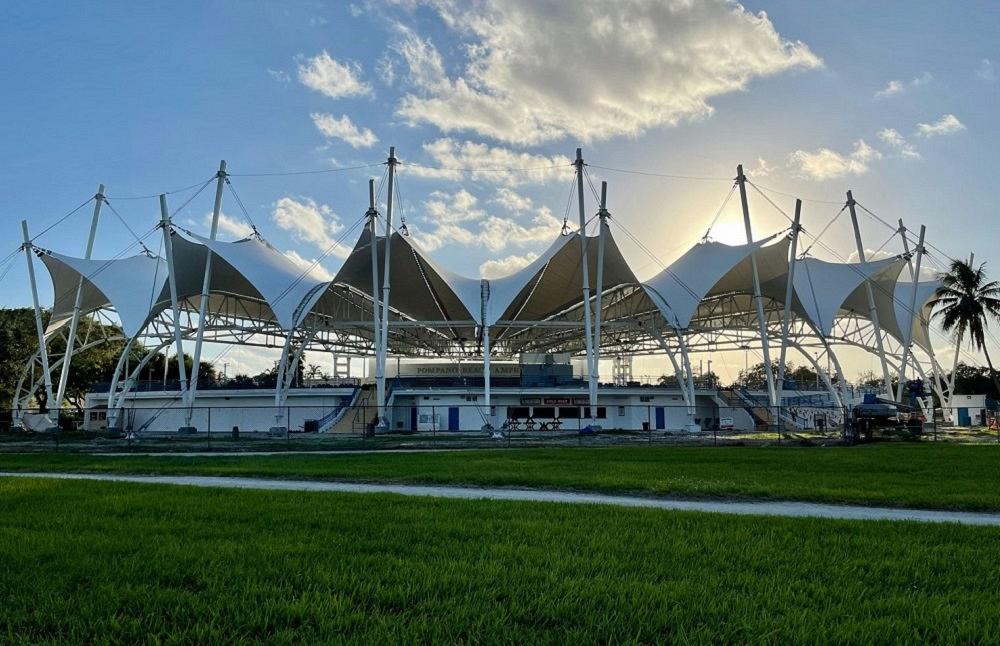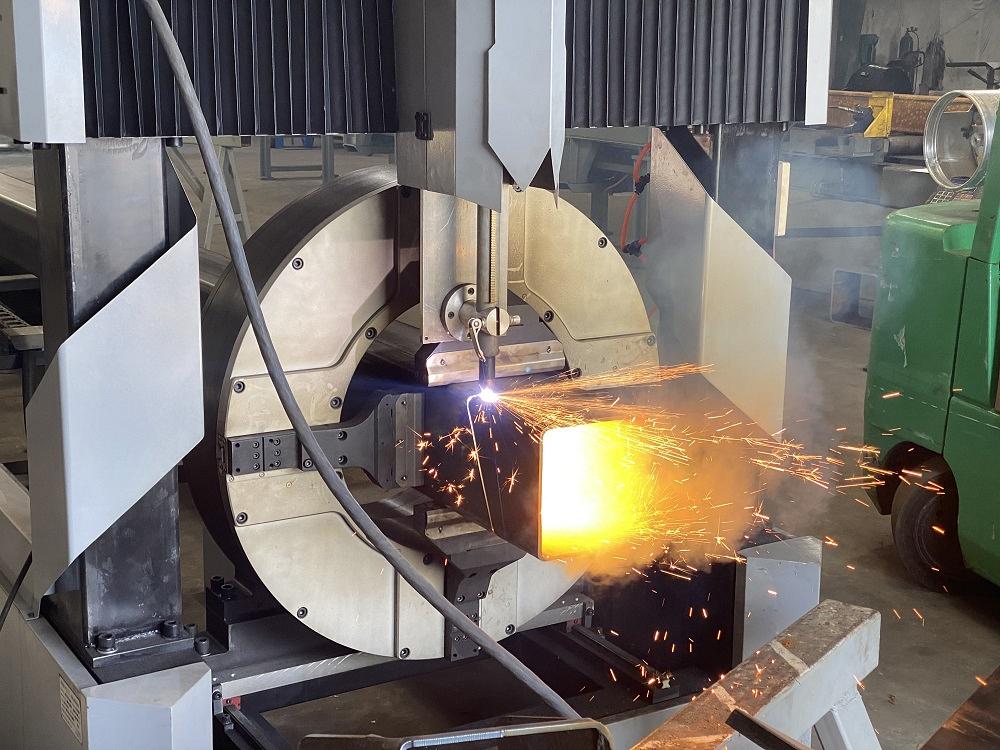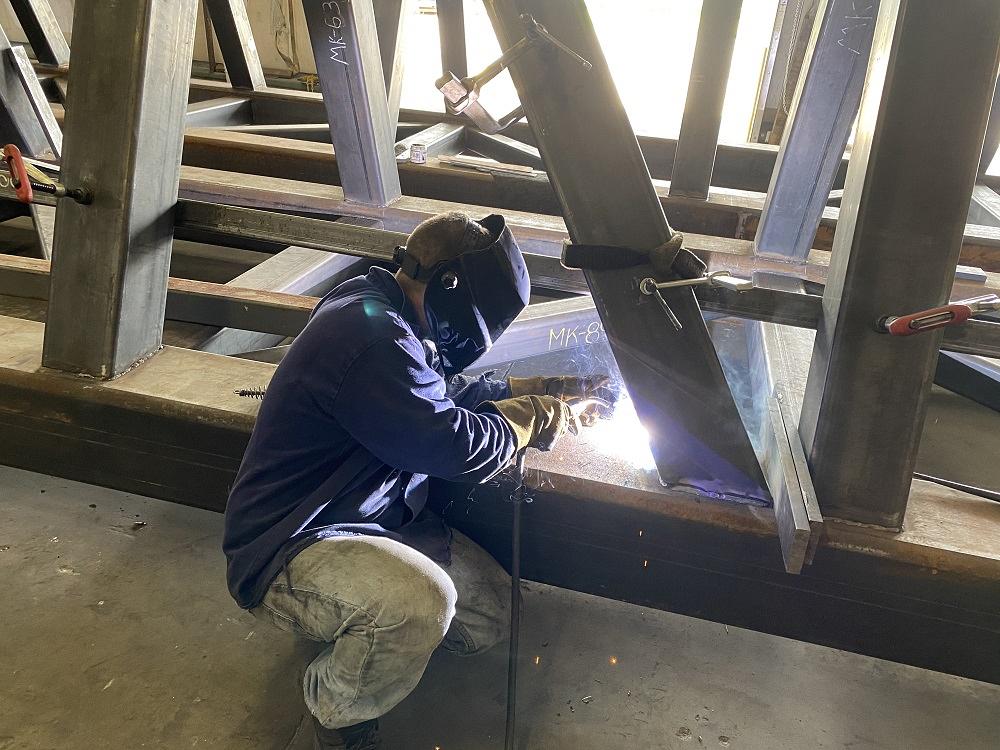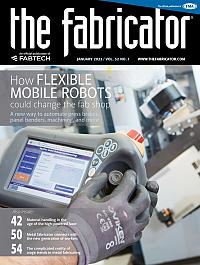Senior Editor
- FMA
- The Fabricator
- FABTECH
- Canadian Metalworking
Categories
- Additive Manufacturing
- Aluminum Welding
- Arc Welding
- Assembly and Joining
- Automation and Robotics
- Bending and Forming
- Consumables
- Cutting and Weld Prep
- Electric Vehicles
- En Español
- Finishing
- Hydroforming
- Laser Cutting
- Laser Welding
- Machining
- Manufacturing Software
- Materials Handling
- Metals/Materials
- Oxyfuel Cutting
- Plasma Cutting
- Power Tools
- Punching and Other Holemaking
- Roll Forming
- Safety
- Sawing
- Shearing
- Shop Management
- Testing and Measuring
- Tube and Pipe Fabrication
- Tube and Pipe Production
- Waterjet Cutting
Industry Directory
Webcasts
Podcasts
FAB 40
Advertise
Subscribe
Account Login
Search
Florida fabricator grows in the unique niche of architectural fabric
Metal fabrication shop thrives where fabric and structural steel meet
- By Tim Heston
- January 8, 2022
- Article
- Shop Management

The Pompano Beach Amphitheater uses a combination of fabric and structural steel, all held in tenson by a variety of connections.
One sunny Florida afternoon, German Buitrago pointed to the expansive awning that shelters the new Pompano Beach Amphitheater. The sweeping lines are created by expertly formed structural steel supporting stretched fabric. Thing is, “supporting” really isn’t the right word. The entire structure, including the coated fabric that swoops dramatically above and between the structural steel members, is in tension.
“Once it’s in tension,” Buitrago said, “the fabric behaves as strongly as steel.”The technical name for it is a tensile membrane structure, and fabricators who build them play in the highly specialized niche of architectural fabric.
Buitrago and his business partner Tim Nee are co-owners of Big Span Structures, a metal and fabric fabricator based in Summerfield, Fla. It has all the trimmings of a modern fab shop: 3D plasma cutting for structural shapes, a plasma cutting table, and press brakes. But it also employs architects and engineers and runs an ultraflexible welding and assembly operation, one that can change completely from one job and even one shift to the next.
They all work together to build utilitarian structures that make artistic statements. Some are stark, others whimsical, but all show what can happen when fabric and metal are fabricated in perfect tension.
Making Fabric as Strong as Steel
Buitrago has worked in the architectural fabrics business since 1985, Nee since 1993. Their careers crossed paths many times, and by 2008 the two decided to go into business together. From that partnership sprang Big Span.
The two purchased a 50,000-sq.-ft. plant, a portion of which was dedicated to fabric fabrication, the rest dedicated to fabricating and assembling the structural steel members. Today the company’s 30,000-sq.-ft. structural steel fabrication and assembly plant sits on a 7-acre lot outside Summerville, just south of Ocala—plenty of room for big projects. In 2017 it moved its fabric fabrication to a 45,000-sq.-ft. plant in Guadalajara, Mexico.
Like the welding of metal, the radio frequency (RF) welding of fabric—coated by either polyvinyl chloride (PVC) or polytetrafluoroethylene PTFE (fiberglass)—is itself a science. As Buitrago explained, “To weld PVC, you apply heat to it. But in order to get adhesion, the heat needs to be generated by the RF machine. By applying RF, you break the molecules of the PVC itself for about five seconds, then you let it cool for 20 seconds. Once cooled, it becomes one fused joint stronger than the fabric itself.
“With PTFE, we use a similar technique, but instead of RF, we apply heat with steel plates heated to between 500 and 600 degrees F, just for a few seconds. Once it cools, again, it becomes a joint that’s stronger than the fabric itself.”
The CNC Department
The company’s Florida campus has two facilities, one dedicated to CNC fabrication equipment, another for welding and assembly. The CNC shop cuts steel plate and pipe with high-definition plasma cutting equipment. “This includes a CNC plasma machine that can cut in three dimensions,” Buitrago said. The machine slices through round, rectangular, and square tubing as well as various structural shapes. “We essentially can cut any piece of steel up to 1.5 in. thick.”
The shop also has plate rolls along with a horizontal three-roll bender that can form tube and structural shapes up to 8 in. in diameter. It sends larger members to a specialty roller-bender operation. “They’ve rolled tubes up to 30 in. diameter for us,” Buitrago said.
Assembly, Starting With a Blank Canvas
Although Big Span has plenty of modern equipment, its fab shop isn’t unique. Workers cut plate and structural shapes. Its blast cleaning and wet painting department handles single workpieces or welded subassemblies. Nothing unusual there.

German Buitrago (left) and Tim Nee, co-founders of Big Span Structures, stand near the Pompano Beach Amphitheater, a job showcasing how structural steel and PVC-coated fabric work together in tension.
Walk to the welding and assembly facility, though, and the unusual nature of Big Span’s fabrications comes to light. Free of columns and other obstructions, the entire space changes depending on the mix of jobs on the floor. Production managers effectively start with a blank canvas every few weeks, designing the factory floor to suit a specific mix of jobs.
The shop hires welders who know how to work out of position and weld a variety of joint configurations. Entire welding setups—the wire feed, shielding gas, power sources—can be moved on carts wherever they’re needed. That’s often next to some unique welding tables with custom fixtures. “German actually designed these tables,” Nee explained. “They have adjustable plates that are essentially go/no-go gauges.
“It’s not like we’re fabricating a building,” Nee continued. “We’re actually fabricating a piece of art. It’s as if we’re making a statue. We might need to carve it differently every time we need to make a new one. With certain jobs, sometimes we get lucky and have a lot of repetitive pieces. When this happens, the floor might look like a normal factory, [with rows of weld cells fabricating pieces that are sent to painting and final assembly]. But there are other times when everything is different, and we need to accommodate. The project dictates how we lay the factory out.”
In late 2021 Buitrago pointed to a floor divided into three distinct sections—three value streams, designed specifically for three projects, all running concurrently. “It depends on the size of the project, but we try not to have more than four going on at once, especially if jobs require a large number of small pieces. With multiple projects, we can have up to 3,000 small plates and other shapes being cut on our CNC equipment, and they all go to different projects.”
Marrying the Steel and Fabric
Before shipping a project on-site, Big Span performs a test assembly outside the plant to ensure all pieces mate properly and to avoid issues in the field. Here, assemblers work with custom devices that help marry the fabric and structural steel, bringing everything to just the right amount of tension.
“We design plates and some unique devices that are used strictly to grab the edge of the fabric and pull it toward the clamping system of the steel,” Nee said. “And, of course, everything is precalculated when we do the patterning of the fabric. We know we have to stretch the fabric a specific amount in each direction. The tensioning devices make sure that the fabric, once it’s tensioned, behaves as strongly as the steel.”
Big Span’s architects and engineers perform finite element analyses (FEA) to test the tension and compression between the structural steel and fabric and to ensure the pieces meet snow-load and other weather-related requirements. Engineers aren’t necessarily worried the fabric will tear under pressure. In fact, they’re more worried about the structural steel. If the steel structure is sized incorrectly or otherwise designed or fabricated improperly, “the fabric can actually tear the steel structures apart,” Nee said. “You can literally twist a truss with the fabric. All components work in conjunction with each other as they go into full tension.”
Unique Design, Fabrication Challenges
The shop also works with a variety of connections, many of which would impress any connection engineer working at a structural fabricator or detailer. “We are constantly designing new connections to accommodate certain shapes,” Buitrago said.
These connection points involve more than just the common structural shapes. “We often customize our structural components,” Buitrago explained. “Sometimes we have a tube that goes from 18 in. in diameter down to 12 in. diameter, and the tube spans 50 ft. No one makes a tube like that, so we have to fabricate it by welding tube sections together.”
Some designs also call for tight radii on structural members, a decision often made for aesthetics. “Again, these can be looked at as works of art,” Nee said. “We use certain elements to make the structure more aesthetically pleasing. This means, when bending, we use certain tricks to bend members, especially tube, to a tight radius.” They watch the ovality of the round tube and wrinkling on square and rectangular tube, using mandrels and other tricks of the trade (such as packing sand within the tube ID or using water or air pressure).
The company fabricates everything within very tight tolerances, so tight that engineers visit the job site and, with a 3D point-cloud scanner, ensure that their digital design accommodates any obstacles or other variables in construction—especially important if the fabric structure will be attached to new or existing structures.
“Once everything is produced at the shop," Nee said, “we go to the site again with the scanner to make sure we are within tolerance.”
One Among the Few
Big Span employs about 50 people, but it also works with about 100 independent contractors and installation crews around the U.S. The specialized nature of those teams reflects the overall nature of Big Span’s structural fabricating niche.
Nee summed it up this way: “These are specialized people who have years of experience installing the fabric. It’s a small, tight industry, and we know most of the people in it. The fabric really is unique, and very few companies around the world do the type of work that we do.”
About the Author

Tim Heston
2135 Point Blvd
Elgin, IL 60123
815-381-1314
Tim Heston, The Fabricator's senior editor, has covered the metal fabrication industry since 1998, starting his career at the American Welding Society's Welding Journal. Since then he has covered the full range of metal fabrication processes, from stamping, bending, and cutting to grinding and polishing. He joined The Fabricator's staff in October 2007.
subscribe now

The Fabricator is North America's leading magazine for the metal forming and fabricating industry. The magazine delivers the news, technical articles, and case histories that enable fabricators to do their jobs more efficiently. The Fabricator has served the industry since 1970.
start your free subscription- Stay connected from anywhere

Easily access valuable industry resources now with full access to the digital edition of The Fabricator.

Easily access valuable industry resources now with full access to the digital edition of The Welder.

Easily access valuable industry resources now with full access to the digital edition of The Tube and Pipe Journal.
- Podcasting
- Podcast:
- The Fabricator Podcast
- Published:
- 04/16/2024
- Running Time:
- 63:29
In this episode of The Fabricator Podcast, Caleb Chamberlain, co-founder and CEO of OSH Cut, discusses his company’s...
- Industry Events
16th Annual Safety Conference
- April 30 - May 1, 2024
- Elgin,
Pipe and Tube Conference
- May 21 - 22, 2024
- Omaha, NE
World-Class Roll Forming Workshop
- June 5 - 6, 2024
- Louisville, KY
Advanced Laser Application Workshop
- June 25 - 27, 2024
- Novi, MI

































